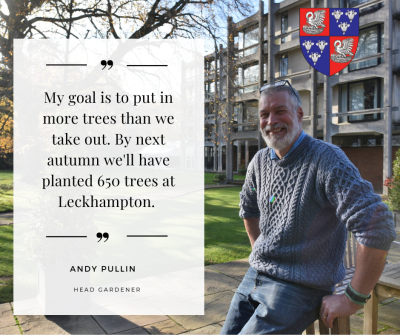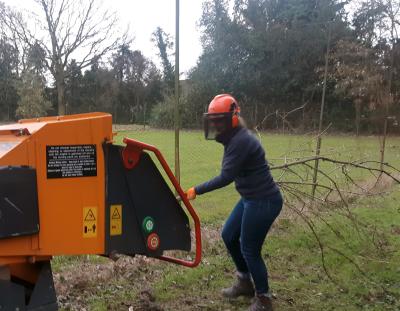Grounds and Gardens
The gardens at Leckhampton are a year-round delight for both people and wildlife. The gardening team continue to improve the planting and management of the gardens to create a peaceful place for students, staff and Fellows, and to encourage wildlife to thrive. The video below shows the gardens at Leckhampton through years and across the seasons.
- Tree management
-
We are lucky to have many mature trees across our estate, many of which are under protection orders, including:
- a 400-year-old mulberry (Morus nigra) in the Fellows' Garden at Old House
- a grand copper beech (Fagus sylvaticus atropurpurea) that was planted at Leckhampton House when the house was built in 1893
- several Atlas cedars (Cedars atlantica) in excess of 75 high and wide, planted circa 1890 as prestigious exotics
- a dawn redwood (Metasequoia glyptostroboides) near the swimming pool
- A Persian ironwood (Parrotia) which gives great colour in autumn
Mature trees such as these provide invaluable habitat for birds and other creatures (buzzards and other raptor regularly perch on the dawn redwood), create shade and of course absorb carbon dioxide.
The gardening team carry out an active programme of tree management, clearing out trees in a lot of the neglected, background areas which has given space and light to the remaining trees. Head Gardener Andy Pullin's approach is to "put in more trees than you take out". By next autumn the team will have planted 650 trees at Leck.
Many of these trees come from the Woodland Trust, who offer saplings to schools & colleges, with various themes. Options include the 'year-round colour', 'working wood' and the 'wild harvest' selections. More details are available from the website below. This year we have chosen 480-tree wildlife pack, which includes hawthorn, hazel, silver birch, rowan, sessile oak and blackthorn.
These saplings will be delivered in March 2023, then potted up, and kept at our greenhouse facility on Sidgwick Avenue until we plant out in November next year. The reason for not planting immediately is guarantee that the saplings survive through next summer, in the event that we have another year of record-breaking temperatures.
- Green waste
-
Much of our green waste is composted or repurposed.
Smaller branches and leaves are put into our compost system. We use the compost widely across the gardens, particularly around the bases of trees.
We put some slightly larger branches through a wood chipper and use the resulting wood chips to mulch around the bases of trees and new plantings. For other branches we use a technique recommended by Senior Gardener Matt Mace called 'brash' or 'dead hedges'. With this technique, we arrange branches and twigs to form a barrier which can serve several purposes:
- discourage people from walking over sensitive areas
- provide shelter for small mammals and birds
- create a green 'corridor' from one wildlife-friendly area to another
Larger branches are fed through a wood chipper and the resulting wood chips are used as mulch around trees and new plantings (shown below is Domus Bursar Gemma Donaldson trying her hand at wood chipping).
- Propagation
-
Growing our own plants from seed and cuttings is economical and gives us the biggest bang for our buck. The team grows herbaceous perennials from cuttings and divisions, and annual plants from seed in our greenhouse at Middleton House on Sidgwick Avenue.
- Meadow management
-
We are lucky amongst Cambridge colleges to have several mature meadow areas. A large swathe of grassland in the Leckhampton site has been home to perennial lupines since at least the 60s. In addition, we have a Prairie Meadow planted by alumnus garden designer Tom Stuart- Smith. Andy talks about the meadow in this video:
To renew the meadow, the team have cleared out a lot of the moss and thatch by scarifying in order to create a seed bed that they can then overseed. The'throw-and-go seed mix they have chosen was developed at the Cambridge University Botanic Gardens and it contains to encourage bees and other pollinators. They'll also add some umbellifers grown in the greenhouses, as well as some of the original plantings like rudbeckia, coneflowers and monarda.


